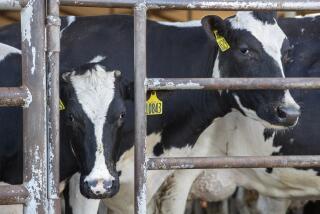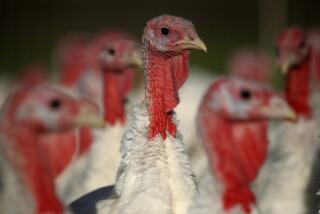Agriculture Dept. Unveils New Meat Inspection Plan
- Share via
WASHINGTON — The Agriculture Department announced a plan Tuesday to bring modern science to meat and poultry inspection, including requiring processing plants to conduct daily tests for salmonella bacteria, the leading cause of food-borne illness.
The long-awaited proposal is a major addition to the visual-inspection system, which is widely seen as ineffective.
Nearly 5 million cases of illness and more than 4,000 deaths may be associated with meat and poultry products each year, the department said.
The proposal mandates scientific testing for bacteria, temperature requirements and anti-microbial treatments. It also places more responsibility on industry to produce safe meat and poultry. Each of the nation’s 6,200 slaughterhouses and processing plants would have to operate under a plan that identifies and eliminates sources of bacterial contamination.
Although about 7,400 federal inspectors examine more than 6 billion poultry carcasses and 125 million livestock carcasses each year, there is a “critical gap” in the current system’s ability to protect public health, the department said.
The first meat-inspection law, passed in 1907, called for carcass-by-carcass examination. Even though scientists have since learned that most of the bacteria that make people sick cannot be detected through sight, smell and touch, the “poke and sniff” inspection system has continued.
The proposal does not eliminate the current system, however, at least for now. Instead, it requires plants to test meat regularly for harmful bacteria and take other steps to improve sanitation.
The proposal consists of an interim plan that takes effect within 90 days of publication of a final set of regulations and a longer-range plan that the industry would have up to three years to implement. After the proposal’s publication in the Federal Register on Friday, the public will have 120 days to submit comments.
Consumer groups, the inspectors’ union and some scientific associations praised the proposal.
More to Read
Sign up for Essential California
The most important California stories and recommendations in your inbox every morning.
You may occasionally receive promotional content from the Los Angeles Times.













